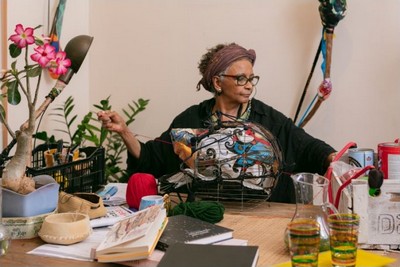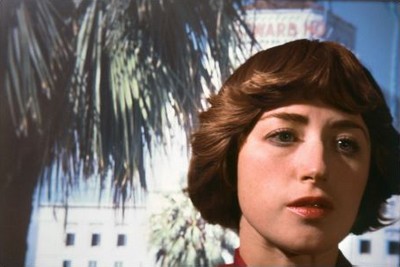Sonia Gomes
O mais profundo é a pele
(Skin is the deepest part)
Pace Gallery, New York
November 4 – December 17, 2022
Courtesy Pace Gallery
Constelação II, 2022
© Sonia Gomes, courtesy Pace Gallery
Pace presents Sonia Gomes’s first-ever solo show in New York at its 540 West 25th Street gallery. Gomes, who is known for her use of textiles and everyday materials in her complex assemblages, brings physicality and movement to the fore of her work. This presentation marks the artist’s first solo exhibition with Pace since she joined the gallery’s program in 2020.
Sonia Gomes, a largely self-taught artist, first gained international recognition when the late curator Okwui Enwezor included her work in the 2015 Venice Biennale. In 2018, she became the first living Afro-Brazilian woman artist to have a monographic show at the Museu de Arte de São Paulo (MASP), and in 2021 she participated in the 13th Gwangju Biennale in South Korea and the Liverpool Biennial in the UK. Born in 1948 in Caetanópolis—which is located in state of Minas Gerais in southeastern Brazil and was once a textile hub—the artist has cultivated a practice anchored by her deft and meticulous manipulation of varied materials. Featuring juxtaposing forms, colors, and media, Sonia Gomes’s abstract assemblages have pushed the boundaries of conventional sculpture, forging connections between memory and abstract imagery.
In this exhibition Sonia Gomes presents works from 2021 and 2022, including hanging, free-standing, and wall-mounted sculptures. The artist’s works often incorporate secondhand, gifted, and repurposed textiles; furniture; driftwood; wire; and other seemingly disparate materials. Through kneading, twisting, and stretching, she grapples with the stories and memories rooted in the fabrics, imbuing her resulting sculptures with personal and political resonances. In her laborious process for creating these multimedia works, Sonia Gomes considers sewing akin to drawing: a means to produce gestural marks and compositional balance.
Two vibrant new works from the artist’s Torções (Twists) sculpture series, which will be included in Pace’s exhibition, reflect her interest in interactions between fabric and iron that create volume. Three pieces in the new series Entre Pérola e Vergalhão (Between Pearl and Rebar)—featuring freshwater pearls amid clusters of different fabrics—evoke shells, cocoons, wombs, nests, and other natural incubators. Supported by rebars, these works stand between three and four feet tall, encouraging viewers to bend their bodies to fully experience their formal nuances.
Among the other highlights in the show is the light installation Constelação II (2022), which projects the intricate linear forms of its constituent bird cage and fabric components as shadows against the gallery wall. In the way of two-dimensional works, the exhibition spotlights eight new pieces from the artist’s Tela-Corpo (Canvas-Body) series, in which she experiments with curved arrangements of graphic media amid color fields. Two hanging sculptures from Gomes’s Relíquia (Relic) series are in the show—these works feature ornate abstractions comprising lace, buttons, various metals, zippers, and other combinations of materials.
A group of layered collages—depicting vibrantly colored natural forms—also figure in the presentation. For these works, Sonia Gomes uses a wide range of materials, including Posca pens and watercolors, to make strokes, chromatic fields, arabesques, hatches, volutes, and stains. Utilizing papers of various textures, weights, and shades, the artist conjures new visual effects in each collage.
A section of the exhibition is dedicated to new works on paper Sonia Gomes created as part of a collaboration with her studio assistant, Juliana dos Santos. These small-scale, lyrical works depict organic—yet otherworldly—forms rendered with watercolor, acrylic, cotton lace, and other materials. A film documenting Gomes and dos Santos’s process and work in the artist’s São Paulo studio will also be on view.
SONIA GOMES (b. 1948, Caetanópolis) combines secondhand textiles with everyday materials, such as furniture, driftwood, and wire, to create abstract sculptures that reclaim Afro-Brazilian traditions and feminized crafts from the margins of history. Juxtaposing tensile and slack forms, Gomes’s contorted sculptures exude a corporeality and dynamism that she attributes to her love of popular Brazilian dances. Gomes uses found or gifted fabrics, which, according to her, “bring the history of the people that they belonged to.” “I give a new significance to them,” she adds. Her assemblages thus tie Brazil’s historical trajectory to the long-disregarded narratives of women, people of color, and countless anonymous individuals.
Through its recycling of used fabric, Sonia Gomes’s work also evinces a principle of thrift that is both a consequence of Brazil’s rapid and uneven industrial development and a dissenting answer to its accompanying culture of wasteful consumption and environmental destruction. As a whole, her art is marked by a decolonizing impulse, providing oblique responses to the social inequities and ecological urgencies of present-day Brazil and, more broadly, a globalized world.
Sonia Gomes’s work was recently acquired by the Guggenheim Museum in New York and Tate in London. She is represented in numerous collections around the world, including the Museum of Contemporary Art Chicago; the Pérez Art Museum Miami; the Rubell Museum in Miami; the Minneapolis Institute of Art; the San Antonio Museum of Art in Texas; the Pinacoteca do Estado de São Paulo; the Museu de Arte de São Paulo; the Museu de Arte do Rio, Rio de Janeiro; the Instituto Inhotim in Brumadinho, Minas Gerais, Brazil; and the Guggenheim Abu Dhabi.
PACE
540 West 25th Street, New York, NY 10001


























